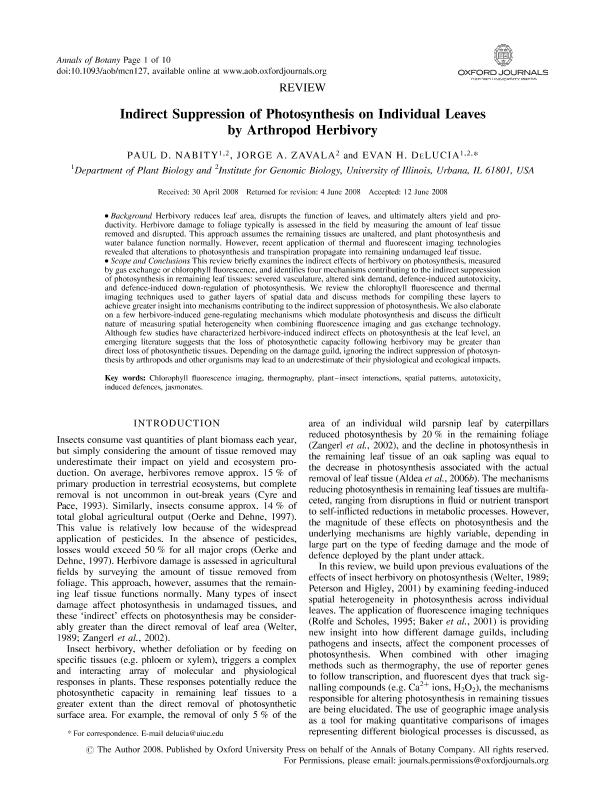Mostrar el registro sencillo del ítem
dc.contributor.author
Nabiti, Paul D.
dc.contributor.author
Zavala, Jorge Alberto

dc.contributor.author
De Lucia, Evan H.
dc.date.available
2018-09-27T16:40:44Z
dc.date.issued
2009-02
dc.identifier.citation
Nabiti, Paul D.; Zavala, Jorge Alberto; De Lucia, Evan H.; Indirect suppression of photosynthesis on individual leaves by arthropod herbivory; Oxford University Press; Annals of Botany; 103; 4; 2-2009; 655-663
dc.identifier.issn
0305-7364
dc.identifier.uri
http://hdl.handle.net/11336/61070
dc.description.abstract
Background: Herbivory reduces leaf area, disrupts the function of leaves, and ultimately alters yield and productivity. Herbivore damage to foliage typically is assessed in the field by measuring the amount of leaf tissue removed and disrupted. This approach assumes the remaining tissues are unaltered, and plant photosynthesis and water balance function normally. However, recent application of thermal and fluorescent imaging technologies revealed that alterations to photosynthesis and transpiration propagate into remaining undamaged leaf tissue. Scope and Conclusions: This review briefly examines the indirect effects of herbivory on photosynthesis, measured by gas exchange or chlorophyll fluorescence, and identifies four mechanisms contributing to the indirect suppression of photosynthesis in remaining leaf tissues: severed vasculature, altered sink demand, defence-induced autotoxicity, and defence-induced down-regulation of photosynthesis. We review the chlorophyll fluorescence and thermal imaging techniques used to gather layers of spatial data and discuss methods for compiling these layers to achieve greater insight into mechanisms contributing to the indirect suppression of photosynthesis. We also elaborate on a few herbivore-induced gene-regulating mechanisms which modulate photosynthesis and discuss the difficult nature of measuring spatial heterogeneity when combining fluorescence imaging and gas exchange technology. Although few studies have characterized herbivore-induced indirect effects on photosynthesis at the leaf level, an emerging literature suggests that the loss of photosynthetic capacity following herbivory may be greater than direct loss of photosynthetic tissues. Depending on the damage guild, ignoring the indirect suppression of photosynthesis by arthropods and other organisms may lead to an underestimate of their physiological and ecological impacts.
dc.format
application/pdf
dc.language.iso
eng
dc.publisher
Oxford University Press

dc.rights
info:eu-repo/semantics/openAccess
dc.rights.uri
https://creativecommons.org/licenses/by-nc-sa/2.5/ar/
dc.subject
Autotoxicity
dc.subject
Chlorophyll Fluorescence Imaging
dc.subject
Induced Defences
dc.subject
Jasmonates
dc.subject
Plant-Insect Interactions
dc.subject
Spatial Patterns
dc.subject
Thermography
dc.subject.classification
Agricultura

dc.subject.classification
Agricultura, Silvicultura y Pesca

dc.subject.classification
CIENCIAS AGRÍCOLAS

dc.title
Indirect suppression of photosynthesis on individual leaves by arthropod herbivory
dc.type
info:eu-repo/semantics/article
dc.type
info:ar-repo/semantics/artículo
dc.type
info:eu-repo/semantics/publishedVersion
dc.date.updated
2018-09-21T20:35:19Z
dc.journal.volume
103
dc.journal.number
4
dc.journal.pagination
655-663
dc.journal.pais
Reino Unido

dc.journal.ciudad
Oxford
dc.description.fil
Fil: Nabiti, Paul D.. University of Illinois at Urbana; Estados Unidos
dc.description.fil
Fil: Zavala, Jorge Alberto. Consejo Nacional de Investigaciones Científicas y Técnicas. Oficina de Coordinación Administrativa Parque Centenario. Instituto de Investigaciones en Biociencias Agrícolas y Ambientales. Universidad de Buenos Aires. Facultad de Agronomía. Instituto de Investigaciones en Biociencias Agrícolas y Ambientales; Argentina. University of Illinois at Urbana; Estados Unidos
dc.description.fil
Fil: De Lucia, Evan H.. University of Illinois at Urbana; Estados Unidos
dc.journal.title
Annals of Botany

dc.relation.alternativeid
info:eu-repo/semantics/altIdentifier/url/https://academic.oup.com/aob/article/103/4/655/164204
dc.relation.alternativeid
info:eu-repo/semantics/altIdentifier/doi/http://dx.doi.org/10.1093/aob/mcn127
Archivos asociados
